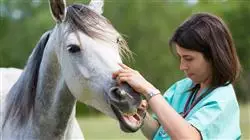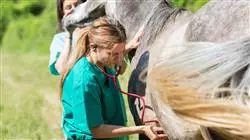
Certificate
The world's largest faculty of veterinary medicine”
Description
A complete and total update in Equine Dermatology, Neurology, Ophthalmology and Endocrinology with the most complete and effective academic program in the online teaching market"

This postgraduate certificate will review the most important aspects of dermatological, neurological, ophthalmological and endocrinological pathologies.
Due to the frequency of these pathologies, it is important to know in depth the different therapeutic options available. In the case of a skin laceration, the objective to be achieved, whenever possible, is the primary healing of the injured tissue. The prognosis of each case will depend on the structure involved, its location and degree of involvement: the worst prognosis traumatisms are injuries affecting anatomical territories such as joints and tendons; joint injuries are relatively frequent and have a poor prognosis; tendon lacerations show a lower incidence, being injuries affecting flexor tendons those with a severe prognosis. These last two types of incidents, in the case of the sport horse, can mean the end of its sporting career and can even have a reserved vital prognosis. Good perioperative management and the use of an appropriate surgical technique will make it possible to preserve the patient's life and, in some cases, his or her return to sports practice at the previous level, since appropriate treatment will make it possible for the affected anatomical region to maintain normal functionality and for the esthetic results to be optimal.
However, there are other interventions that can be challenging for the veterinarian, such as musculoskeletal infections in general and those of bone and synovial structures in particular. In addition, viral and bacterial diseases encompass numerous pathologies that the equine veterinary clinician must know how to recognize and establish treatment guidelines. Fungal and parasitic diseases are the most frequent causes of skin disorders, and in many cases they are highly contagious between individuals, so it is important not only to identify these problems but also to establish appropriate management guidelines to prevent their spread.
In the field of equine dermatology, one of the most common skin problems currently being observed is the allergy caused by mosquito bites, which will be studied in depth in this postgraduate certificate, in addition to skin neoplasms or relatively frequent pathologies in equines, which must be treated very differently depending on the definitive diagnosis, so a detailed and advanced work methodology will be established for the patient with this type of pathology, with special emphasis on the most advanced techniques for treatment.
Join the elite, with this highly effective program and open new paths to your professional progress"
This postgraduate certificate in Dermatological, Endocrine, Blood and Nutrition Disorders in Horses includes the most complete and up-to-date Educational program on the market. The most important features include:
- The development of case studies presented by experts in equine medicine
- The graphic, schematic, and eminently practical contents with which they are created, provide scientific and practical information on the disciplines that are essential for professional practice
- Practical exercises where self-assessment can be used to improve learning
- Special emphasis on innovative methodologies in dermatological, endocrine, blood and nutritional disorders of the horse
- Theoretical lessons, questions to the expert, debate forums on controversial topics, and individual reflection assignments
- Content that is accessible from any fixed or portable device with an Internet connection
A complete Academic program that will allow you to acquire the most advanced knowledge in all the areas of intervention of the equine veterinarian"
Its teaching staff includes professionals from the veterinary field, who contribute their work experience to this program, in addition to renowned specialists from prestigious reference societies and universities.
Its multimedia content, developed with the latest educational technology, will provide professionals with situated and contextualized learning, that is, a simulated environment that will provide immersive study set up to train them in real-life situations.
This program is designed around Problem Based Learning, whereby the specialist must try to solve the different professional practice situations that arise during the academic year. For this purpose, the professional will be assisted by an innovative interactive video system developed by renowned and experienced experts in orthopedic diseases.
With a methodological design based on proven teaching techniques, this innovative program will take you through different teaching approaches to allow you to learn in a dynamic and effective way"

Our innovative telepractice concept will give you the opportunity to learn through an immersive experience, which will provide you with a faster integration and a much more realistic view of the contents: “learning from an expert”
Objectives
TECH's objective is to orient highly qualified professionals for work experience. An objective that is complemented, moreover, in a global manner, by promoting human development that lays the foundations for a better society. This objective is materialized in helping professionals to reach a much higher level of competence and control. A goal that, in just a few months you will be able to achieve with a high intensity and effective program.

If your goal is to reorient your skills towards new paths of success and development, this is your place: a postgraduate certificate that aspires to excellence"
General Objectives
- Identify the different anatomical structures and pathologies of the digestive tract of the horse
- Develop and advance in the most frequent procedures to solve oral cavity pathologies
- Recognize the symptoms of digestive disorders
- Enable the clinician to correctly assess the systemic state of the animal and the consequent severity of the pathology
- Establish diagnostic protocols and generate optimized treatments and prognoses
- Establish optimal preventive medicine criteria and good management guidelines
- Establish an appropriate methodology for the examination of the horse with respiratory or cardiac problems
- Identify all clinical signs associated with respiratory or cardiovascular disease in equines
- Generate specialized knowledge of respiratory and cardiac auscultation
- Establish the specific clinical approach to the horse with a respiratory or cardiovascular disorder
- Identify the pathologies of the urinary system of the horse
- Establish diagnostic protocols to facilitate the recognition of patients with urinary pathology
- Expand the alternatives of possible treatments according to pathological situations
- Recognize the medical and surgical genital pathologies of the stallion and the broodmare, assess their extent and provide appropriate treatments for recovery and restoration of proper reproductive function
- Develop surgical techniques for the resolution of pathologies of the reproductive system that can be performed in the field
Specific Objectives
- To be highly competent in the diagnosis of diseases related to the hemotopoietic and immune system
- Diseases related to the hemotopoietic and immune system
- Prescribe and Interpret Laboratorial Studies of Blood Components
- Recognize and Deal with Endotoxic Shock
- Stabilize the patient quickly and effectively, especially in life-threatening situations
- Proper Feeding and Teaching the Owner How to Do It
- Perform Advanced Nutritional Counseling in Special Cases
- Know the Latest Advances in Equine Antibiotic Therapy
- Know Which Medicinal Plants are Useful in Equine Treatment
- Recognize Cutaneous Neoplasms
- Early Diagnosis of the Same
- Detect, diagnose and treat endocrine diseases
- Recognize Equine Metabolic Syndromes
- Recognize Cushing's Syndrome in Equines
- To know which are the geographic locations with the highest prevalence of these syndromes
- Recognize the Most Affected Breeds
- Prescribe the Appropriate Diagnostic Tests
- Using Conventional and Advanced Techniques in the Approach

A unique, key and decisive training experience to boost your professional development"
Postgraduate Certificate in Dermatological, Endocrine, Blood and Nutrition Disorders in Horses
The care and health of horses are fundamental for their well-being, and in this sense, it is important for veterinary medicine professionals to be up to date on the different disorders that can affect these animals. The Postgraduate Certificate in Dermatological, Endocrine, Blood and Nutrition Disorders in Horses is a unique educational program that reviews the most important aspects of these conditions and the therapeutic options available to treat them. The knowledge and management of the different disorders that can affect equines is essential to ensure their health and welfare. This course will cover everything from skin lacerations to musculoskeletal infections, including viral, bacterial, fungal and parasitic diseases that can affect the skin of horses.
Update your veterinary knowledge completely online
Aspects such as endocrine diseases, which represent a challenge for equine veterinarians, or neurological disorders, which are fundamental in veterinary intervention with these animals, will also be covered. In addition, aspects of hematopoietic treatment and equine nutrition will be reviewed, all this will be presented in an accessible and simple way, thanks to the quality of the contents and the extensive experience of the professionals who have developed this program. In addition, as it is a 100% online qualification, veterinarians will be able to balance their study with their daily obligations, and choose where and when to study at any time. In short, the Postgraduate Certificate in Dermatological, Endocrine, Blood and Nutrition Disorders in Horses is a unique opportunity for veterinary medicine professionals to broaden their knowledge and offer better care to horses. Do not miss the opportunity to access this high-level education, and become an expert in equine health






